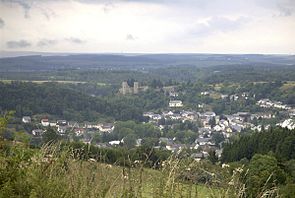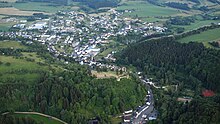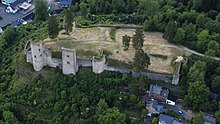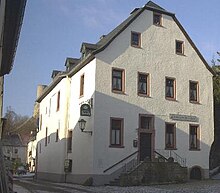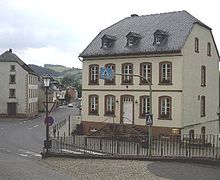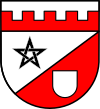Beautiful corners
| coat of arms | Germany map | |
|---|---|---|
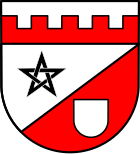
|
Coordinates: 50 ° 9 ′ N , 6 ° 28 ′ E |
|
| Basic data | ||
| State : | Rhineland-Palatinate | |
| County : | Eifel district Bitburg-Prüm | |
| Association municipality : | Prüm | |
| Height : | 400 m above sea level NHN | |
| Area : | 13.36 km 2 | |
| Residents: | 1466 (Dec. 31, 2019) | |
| Population density : | 110 inhabitants per km 2 | |
| Postal code : | 54614 | |
| Area code : | 06553 | |
| License plate : | BIT, PRÜ | |
| Community key : | 07 2 32 304 | |
| Community structure: | 2 districts | |
| Association administration address: | Tiergartenstrasse 54 54595 Prüm |
|
| Website : | ||
| Local Mayor : | Johannes Arenth ( CDU ) | |
| Location of the local community Schönecken in the Eifelkreis Bitburg-Prüm | ||
Schönecken is a local community in the West Eifel in the Eifelkreis Bitburg-Prüm in Rhineland-Palatinate and belongs to the Verbandsgemeinde Prüm . Schönecken is designated as a basic center according to the state planning .
geography
Schönecken lies on the Nims at an altitude of about 400 to 550 m above sea level. NHN . In north and west direction, the Schönecker Schweiz borders the place, the largest nature reserve in the Eifelkreis Bitburg-Prüm. Here you will find, among other things, rare insects and orchid species, limestone grasslands and extensive hiking trails. Schönecken is located in the middle of the Prüm Kalkmulde , a largely untouched karst landscape.
The municipality includes the districts of Schönecken with the Weberhof residential area and Wetteldorf with the Auf dem Bellert, Hauenborn, Herchenbach and Irsfelderhof residential area .
history
The first settlements in the Schönecken area go back to the Celtic period (around 400 BC to 100 AD). The Keltenfliehburg (massive dolomite blocks up to about 20 m high) and some Celtic graves show the first traces of settlement. Traces from the late Roman period can be seen in the form of the Roman road Trier – Cologne in the Weißenseifen area.
In 762 King Pippin donated the Wetteldorf farm to the Prüm Abbey . The Counts of Vianden became the abbey patrons .
In 933, "Schöneck" was mentioned for the first time in the Prüm Abbot's interest register and with the rise of the Prüm Abbey, the Schönecken area also gained in importance.
The further history of Schönecken is mainly characterized by the construction and ownership of the “Clara Costa” castle, which was built in the 12th century. With a length of around 120 m and a width of 60 m, this was probably one of the largest weir systems in the entire West Eifel. Located on a ridge, it is evidence of a high level of military strength.
In 1264, Count Heinrich von Vianden took Schönecken Castle as his residence and called himself Herr von Schönecken. Until 1480, the castle and the rule over Schönecken changed hands several times and only then became permanently (until 1794) property of the Electorate of Trier . In the middle of the 16th century, Schönecken became the seat of an Electoral Trier office and a court headed by an official. There were about ten parishes with 30 villages in the district.
During the local fire in 1802, the castle was partially damaged and stones, wood and roof slate were partially used to rebuild the burned place.
In 1848 the castle ruins became the property of the Prussian state; today it belongs to the state of Rhineland-Palatinate . 1970–1975 defense towers and defensive walls of the castle ruins were renovated by the Rhineland-Palatinate palace administration.
The history of the castle is described in more detail under Castle Schönecken .
In 1960, the two previously independent communities Schönecken and Wetteldorf were merged under the name Schönecken-Wetteldorf. On June 1, 1967, the community "Schönecken-Wetteldorf" was renamed "Schönecken".
- Population development
The development of the population of Schönecken in relation to today's municipal area; the values from 1871 to 1987 are based on censuses:
|
|
politics
Municipal council
The municipal council in Schönecken consists of 16 council members, who were elected in the local elections on May 26, 2019 in a personalized proportional representation, and the honorary local mayor as chairman.
The distribution of seats in the municipal council:
| choice | SPD | CDU | FWG | total |
|---|---|---|---|---|
| 2019 | 2 | 7th | 7th | 16 seats |
| 2014 | 2 | 7th | 7th | 16 seats |
| 2009 | 2 | 6th | 8th | 16 seats |
| 2004 | 3 | 9 | 4th | 16 seats |
- FWG = Free Voting Community Schönecken e. V.
Local mayor
The local mayors since 1960:
- 1960–1961: Nikolaus Kruft
- 1961–1974: Servatius Breuer
- 1974–1979: Nikolaus Knauf
- 1979–1999: Nikolaus Geisen
- 1999-2006: Paul Ludwig
- 2006–2009: Werner Krämer
- 2009–2019: Matthias Antony
- since 2019: Johannes Arenth
coat of arms
| Blazon : "Under a silver shield head with a red pewter cut of silver over red divided obliquely to the left, a black Alb cross above, a silver shield below." | |
|
Foundation of the coat of arms: Schönecken consists of the two municipalities Schönecken and Wetteldorf, which were independent until 1960. Until the 16th century, Schönecken belonged to the Electorate of Trier , Wetteldorf to the territory of the Princes' Abbey . It was united with the Electorate of Trier in 1576. The shield colors red and silver are the colors of both Kurtrier and the Prüm Abbey. Reference is made to Schönecken Castle by the tin cut in the shield head. The seal of the Schöffen von Schönecken or the court Wetteldorf shows a Alb cross ( pentagram ) as a symbol . The formation of the coat of arms refers to this old seal tradition.
The noble lords of Schönecken carry a seal through Hartard von Schönecken in 1350, which shows a little silver label in red. The lords of Schönecken were the owners of the castle, the remains of which stand on a dominant hill above the town. |
Culture and sights
Due to the comparatively little destruction in the Second World War, there are still around 120 in the old town center from the 16th to the 19th century, some of which, such as the " Kellnerei " or the "Hermann-von-Hersel- Haus ", today Haus Arenth, are under monument protection .
Buildings
Double church "Our Lady and St. Leodegar"
The double church in the Wetteldorf district is a late Gothic building with a stately west tower that was expanded in the 20th century by a large extension. It contains an epitaph from 1592, a tower monstrance from St. Vith (1567/68), a Vespers image from around 1500 and several figures of saints from the 18th century.
From a late Gothic hall with a retracted choir closed on three sides and a stately west tower, a basilica was built in 1875 and 1882 by adding two aisles. In 1955/56 a considerably larger new building was added to the south side of the church, which uses the south aisle as a gallery. The formerly unused old building was thoroughly restored in 1976 on the outside and inside in the 1990s and reopened in 1995 as a weekday church and for services with a low number of visitors; the north aisle was demolished in 1976 to widen Nimstalstrasse. The north side facing the street now again shows the picture from around 1500, as the buttresses in the arcade pillars that reached up to the eaves were preserved. The windows were reconstructed based on the model of the chancel window, which had two-lane tracery in 1883. Cornices divide the tower into three storeys of different heights, with an eight-sided, strongly drawn-in pointed helmet at the end. In the northern corner between the tower and the ship there is a polygonal stair tower. The main altar, the pulpit and part of the stalls have been preserved from the neo-Gothic furnishings made after 1882. In 1921 the figural wall paintings by Nikolaus Krämer were created . The tomb of Hermann von Hersel, who died in 1592, can be found in the choir.
Chapel of St. Anthony
The Schönecken chapel is popularly referred to as the "castle chapel", but this is not applicable: There was a separate chapel at the castle, today's "castle chapel" was a branch church of the Wetteldorf parish church for the citizens of Schöneck as the "bynnen Schoneck yn dem Dale chapel" an dem Berghe "and consecrated in 1484. In 1790 there was an extension to today's entrance page. It is furnished partly in baroque style , partly in neo-Gothic style . A former altarpiece dates from 1622.
Art exhibitions are occasionally held in the castle chapel, and Catholic services are also celebrated at irregular intervals (for example during the chapel festival). In 2012 an application was made for the profanation of the building owned by the Schönecken civil parish in order to be able to apply for further subsidies for the renovation of the building. An access road to the chapel was only completed in 2015, otherwise it can only be reached by stairs on the castle slope.
See also: List of cultural monuments in Schönecken
See also: List of natural monuments in Schönecken
Regular events
- Every second year, the castle chapel festival takes place on the first Sunday in July at the Alten Amt / FIF in Schönecken.
- The traditional Schöneck egg layer always takes place on Easter Monday .
regional customs
The Schönecker Eierlage is one of the oldest Easter customs in Western Europe and it was first documented in 1764. According to a legend, the egg layer was created in 1500 and the start of a folk festival on Easter Monday. The egg layer is organized by a bachelor called "Zalditschen" and is a regional crowd puller .
At the Schönecker Eierlage, a packer and a runner compete against each other, both bachelors . The runner has to run to the village of Seiwerath and come back with a confirmation from the barrier recipient , he covers 7.2 km and has to overcome 150 meters in altitude. The gatherer has 104 eggs in the meantime, that at a distance of a cubit : lie (in this case 0.625 m) in a line at the starting point, gather up , pick up so one at a time to run back to the starting point and place in the provided there basket without damaging an egg . According to the Gaussian formula he covers a total of 6.6 km, although the distance of the eggs laid is only 65 m. The last egg is allowed to be damaged on the way to the target, usually it is thrown into the air. The winner is who of the two has completed his task first.
Economy and Infrastructure
According to state planning, Schönecken is a primary center with a primary school and a kindergarten. Wood and metal processing companies are the most important employers in the area, providing around 250 jobs.
The place has a youth camp, a private youth hostel, a holiday village as well as hotels and restaurants. Medical care is ensured on site, and the necessary shopping facilities for daily needs can also be found in Schönecken. The indoor and outdoor pools are no longer in operation.
Personalities
- Hans-Wilhelm Schreiber (1924–2004), visceral surgeon and university professor
- Christoph Mancke (* 1953), sculptor
- Hans Josef Haas (* 1956), lawyer, Vice President of the General Customs Directorate
- Rita Wagner (* 1958), politician (FDP)
natural reserve
- On November 25, 1991, the nature reserve Schönecker Schweiz was designated with the number NSG-7232-004.
literature
- Gernot Ludwig: Schönecken as it used to be - a review in old postcards and photos. Self-published, 11/1995.
- Gernot Ludwig: Schönecken - that's how it used to be. History Association of Prümer Land, 11/2000.
- Wolfgang Spang: The gentlemen from Schönecken. Their gender, their castle and their time: around 1250 to around 1550. Self-published, 1996, ISBN 3-9802504-4-X .
Web links
- Internet presence of the local community Schönecken
- Schönecken on the website of the Association of Prüm
- To search for cultural assets of the local community Schönecken in the database of cultural assets in the Trier region .
Individual evidence
- ↑ a b State Statistical Office of Rhineland-Palatinate - population status 2019, districts, municipalities, association communities ( help on this ).
- ^ A b State Statistical Office Rhineland-Palatinate: My village, my city. Retrieved January 19, 2020 .
- ↑ State Statistical Office Rhineland-Palatinate (ed.): Official directory of the municipalities and parts of the municipality. Status: January 2019 [ Version 2020 is available. ] . S. 104 (PDF; 3 MB).
- ↑ Page consolidation at www.schoenecken.com
- ↑ Official municipality directory (= State Statistical Office of Rhineland-Palatinate [Hrsg.]: Statistical volumes . Volume 407 ). Bad Ems February 2016, p. 187 (PDF; 2.8 MB).
- ^ The Regional Returning Officer Rhineland-Palatinate: Local elections 2019, city and municipal council elections.
- ^ The Regional Returning Officer Rhineland-Palatinate: Municipal elections 2014, city and municipal council elections.
- ↑ page officials at www.schoenecken.com
- ↑ Declaration of the coat of arms. Retrieved September 28, 2016 .
- ↑ For the distribution and origin of the custom see https://www.eierlage.de/im-vergleich
- ↑ The process is described with a photo: https://susanne-wingels.de/viel-mehr-als-nur-eierlaufen-hase-und-igel-am-ostermontag-bei-der-schoenecker-eierlage .
- ↑ The nature reserves in Rhineland-Palatinate. Retrieved January 19, 2020 .



